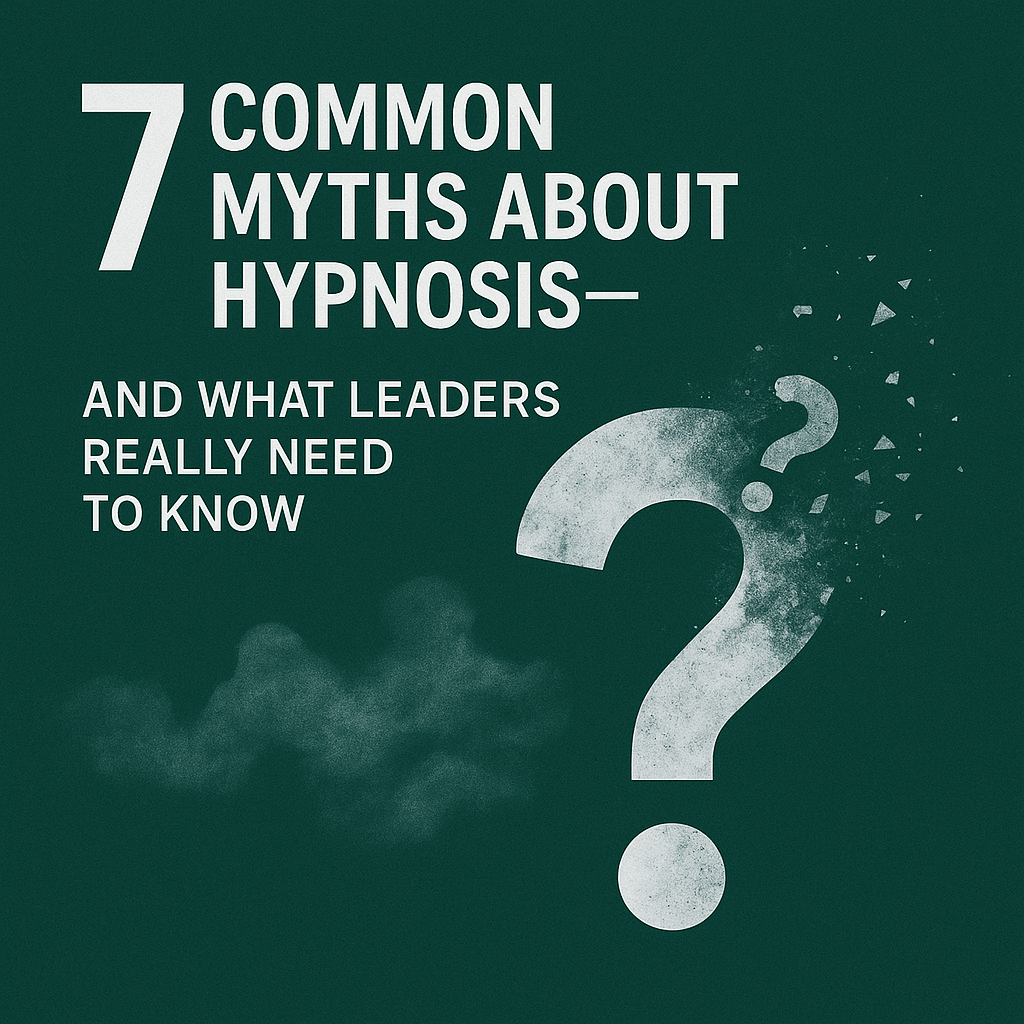In a world where effective leadership demands innovative thinking and emotional intelligence, hypnosis often remains misunderstood, clouded by myths that do a disservice to its potential benefits. Imagine having a tool that enhances focus, reduces stress, and hones decision-making—all essentials for a leader navigating complex challenges. Yet, many of us are led astray by misconceptions about hypnosis, leaving an untapped resource in our journey to becoming better leaders.
Consider the countless times you’ve faced stress-induced mental blocks or needed a fresh perspective to solve a daunting problem. What if hypnosis could be the secret weapon to overcoming these hurdles? Before dismissing the idea as mere “mind control” or “mystical mumbo-jumbo,” it’s crucial to delve beyond the myths. This blog post is an invitation to explore the truths, separating fact from fiction, and uncovering how hypnosis can truly empower today’s leaders.
Debunking Myth Hypnosis as Mind Control
One of the most persistent myths surrounding hypnosis is the notion that it allows the hypnotist to seize complete control over a person’s mind, dictating every thought or action. This misconception likely stems from sensationalized portrayals in films and stage shows, where participants appear to obey commands like puppets on strings. In reality, hypnosis is a collaborative process. The subject remains fully aware of their surroundings and retains ultimate autonomy over their choices and behaviors.
During a typical hypnosis session, a trained professional guides the participant into a deeply relaxed, highly focused state. While in this trance-like condition, individuals often experience heightened suggestibility—meaning they are more receptive to positive, goal-oriented prompts. However, no one under genuine hypnosis is compelled to act against their moral code or engage in behaviors they find objectionable. Hypnosis cannot override core values or personal ethics; it facilitates an internal shift in perception rather than the external imposition of will.
The Science Behind Hypnosis: Understanding the Process
Far from mystical or paranormal, hypnosis is supported by scientific research that explores how focused attention and relaxation can alter brainwave patterns. By entering a trance-like state, individuals harness the power of their subconscious mind, enabling them to reframe beliefs and behaviors more effectively.
Researchers use neuroimaging to observe changes in the brain during hypnosis. These studies reveal shifts in the activity of regions responsible for attention, self-awareness, and emotional regulation—underscoring hypnosis as a legitimate psychophysiological phenomenon rather than an act of “mind control.”
Neurological Mechanisms
Functional MRI and EEG studies have shed light on the neurological underpinnings of hypnosis, demonstrating that this practice can induce significant changes in brainwave activity. During hypnosis, there is typically an increase in theta waves—slow-frequency oscillations associated with deep relaxation, creativity, and access to the subconscious. At the same time, beta waves—linked to active problem-solving and conscious thought—tend to decrease.
Moreover, hypnosis has been shown to alter connectivity between the prefrontal cortex, which governs decision-making and critical reasoning, and the anterior cingulate cortex, involved in attention and motivation. This modulation of brain networks helps explain why participants report heightened focus and reduced internal distractions. By synchronizing neural pathways, hypnosis supports a state of calm concentration where constructive suggestions can bypass ingrained cognitive barriers.
Stages of Hypnosis
Hypnosis typically unfolds in three distinct stages: induction, deepening, and suggestion. During induction, the hypnotist employs soothing verbal cues or guided imagery to help the participant relax and narrow their attention. Common techniques involve progressive muscle relaxation, focused breathing, or visualization exercises.
Once the individual enters a light trance, the practitioner deepens the state through more targeted suggestions, encouraging the participant to drift into a deeper level of relaxation. In this phase, the brain shifts further into theta-dominant patterns. Finally, during the suggestion stage, the hypnotist introduces positive affirmations or goal-oriented prompts—tailored to the participant’s leadership objectives, such as boosting confidence, reducing stress, or enhancing decision-making. This structured approach ensures hypnosis remains a safe, effective tool for professional development.
Common Applications of Hypnosis in Leadership Development
Hypnosis offers leaders a versatile toolkit for improving core competencies, from emotional regulation to strategic thinking. By leveraging trance-like states, executives can access heightened creativity, bolster resilience under pressure, and cultivate a growth-oriented mindset.
While hypnosis is not a magic bullet, its integration into leadership training programs has shown promising outcomes in areas such as stress reduction, enhanced communication, and improved problem-solving capabilities. Below are two primary applications that have gained traction among forward-thinking organizations.
Enhancing Decision-Making
Effective decision-making often requires a balance of analytical reasoning and intuitive insight. Hypnosis can facilitate this equilibrium by quieting the overactive conscious mind, allowing leaders to tap into deeper sources of wisdom. During guided trance sessions, professionals learn to recognize and override cognitive biases that may cloud judgment—such as confirmation bias, anchoring, or loss aversion.
By practicing self-hypnosis techniques focused on clarity and perspective, leaders can approach complex scenarios with renewed objectivity. Research indicates that participants who regularly engage in hypnosis report greater confidence when evaluating risks and opportunities, leading to faster, more decisive actions. This heightened decisiveness not only accelerates project timelines but also instills trust among team members who value clear, unwavering direction.
Boosting Team Collaboration
Strong teams thrive on empathy, active listening, and mutual respect—qualities that hypnosis can help cultivate within leadership. Guided hypnosis sessions often include visualization exercises designed to strengthen emotional intelligence. Leaders imagine positive interactions with colleagues, reinforcing nonverbal communication skills and fostering an inclusive mindset.
When leaders practice these internally through hypnosis, they become more attuned to team dynamics, recognizing unspoken concerns and adapting their approach accordingly. This empathic attunement translates into meetings where every voice feels heard, resulting in more innovative solutions and higher morale. Organizations that incorporate hypnosis-based EI training often report improved retention rates and a more cohesive corporate culture.
Debunking Myth Hypnosis as Mystical or Supernatural
Another common misconception is that hypnosis involves mystical chants, secret rituals, or the invocation of supernatural forces. In reality, hypnosis is rooted in psychology and neuroscience—not the occult. It hinges on well-established principles of attention, suggestion, and relaxation.
Historically, hypnosis has been practiced in various forms, from Mesmer’s 18th-century “animal magnetism” to modern clinical hypnotherapy. Today’s practitioners rely on standardized protocols validated by empirical research. These methods eschew theatrical elements in favor of structured techniques—ensuring sessions remain evidence-based and ethically sound rather than veering into the realm of showmanship or mysticism.
By demystifying the process, organizations can embrace hypnosis as a scientifically grounded leadership development tool. When leaders recognize its psychological underpinnings, they become more open to leveraging trance states for measurable performance gains, rather than dismissing it as fanciful or irreverent.
Exploring the Benefits of Hypnosis for Stress Management
In high-stakes corporate environments, chronic stress can erode productivity, creativity, and overall well-being. Hypnosis offers a structured approach to stress management by guiding individuals into a state of deep relaxation, where the body’s fight-or-flight response settles into equilibrium.
Regular hypnosis sessions help recalibrate the autonomic nervous system. By lowering cortisol levels and increasing production of feel-good hormones like serotonin and endorphins, participants experience reduced anxiety, improved sleep quality, and sharper cognitive function. These physiological changes translate into clear-headed decision-making and greater resilience when navigating tense boardroom negotiations or looming deadlines.
Moreover, self-hypnosis techniques empower leaders to tap into this calm state on demand. A brief, focused breathing exercise or mental imagery rehearsal before a critical presentation can steady nerves and heighten focus. Over time, these micro-practices build an internal stress buffer—ensuring that temporary challenges don’t escalate into burnout or fatigue.
Ethical Considerations in Using Hypnosis for Leadership Enhancement
While hypnosis can yield powerful benefits, ethical practice is paramount. Leaders and practitioners must ensure informed consent, transparency, and respect for individual autonomy. Participants should be fully briefed on the process, goals, and potential outcomes before engaging in any hypnosis session.
Privacy is also critical. Hypnosis can sometimes unearth deeply personal memories or emotions. Professionals must create a safe environment, offering the option to pause or withdraw at any time. Confidentiality agreements should be in place, reinforcing trust between the leader, the practitioner, and the team.
Finally, it’s essential to collaborate with certified hypnotherapists or coaches who adhere to industry best practices. Avoid unlicensed “guru” figures whose credentials may be unverified. By upholding rigorous ethical standards, organizations safeguard their reputation and protect the psychological well-being of their leaders and employees.
Debunking Myth Hypnosis Only Works on the Weak-minded
Some dismiss hypnosis as a tool suited only for gullible or easily influenced individuals. This stereotype could not be further from the truth. In fact, many high-performing professionals—CEOs, athletes, military leaders—use hypnosis to sharpen mental toughness and enhance performance under pressure.
Hypnosis requires active cooperation from the participant. Rather than “weak-minded” submission, it demands focus, imagination, and willingness to engage in the process. Those who succeed in hypnosis often exhibit high levels of self-discipline and introspective capacity. They willingly enter a trance to reframe negative thought patterns, conquer fears, or reinforce positive habits.
Research indicates that people with higher absorption—the capacity to immerse fully in sensory experiences—derive the greatest benefits from hypnosis. This trait is not a sign of weakness, but rather a strength, underscoring an individual’s ability to concentrate deeply and adapt mentally. Leaders who embrace hypnosis demonstrate courage and a growth mindset, willing to explore unconventional strategies to optimize performance.
Practical Tips for Leaders Incorporating Hypnosis Techniques
Integrating hypnosis into a busy leadership schedule requires thoughtful planning. Start small: dedicate five to ten minutes each morning to a guided self-hypnosis recording focused on clarity and confidence. Use noise-cancelling headphones or a quiet space to minimize distractions.
Next, identify specific objectives—whether it’s improving public speaking, boosting creativity, or managing stress. Craft concise, positive suggestions for each goal. For example, “I remain calm and articulate when presenting to stakeholders.” Repeat these affirmations during the suggestion phase of self-hypnosis.
Accountability enhances consistency. Partner with a coach or join a peer group where members share experiences and recommended resources. Track progress in a journal: note shifts in sleep quality, mood, or decision-making speed. Over time, refine your hypnosis scripts based on observed outcomes, ensuring the practice remains aligned with evolving leadership challenges.
Embracing the Potential: How Hypnosis Can Transform Leadership Mindsets
Hypnosis holds the potential to catalyze profound shifts in how leaders perceive themselves and their challenges. By harnessing the subconscious mind, leaders can unearth limiting beliefs, replace them with empowering narratives, and cultivate an agile, solution-oriented mindset.
Beyond individual sessions, integrating hypnosis into organizational culture can foster a more reflective, resilient workforce. Teams learn to approach setbacks as growth opportunities, embrace constructive feedback, and maintain composure in volatile markets. The result is not just improved performance metrics, but a more adaptive, emotionally intelligent leadership style that inspires trust and innovation.
Ultimately, dismissing hypnosis as fringe or gimmicky means forfeiting a scientifically validated avenue for personal and professional growth. Leaders who invest in this practice position themselves—and their organizations—to thrive in an increasingly complex world.
Conclusion
Hypnosis is far more than an outdated stage trick or a tool for mind control. As we’ve debunked common myths, the evidence is clear: hypnosis is a science-backed method to enhance focus, reduce stress, and rewire limiting beliefs. For leaders, it offers a gateway to greater self-awareness and peak performance.
By understanding its neurological basics, applications, and ethical boundaries, executives can adopt hypnosis with confidence. Embracing this practice empowers leaders to navigate challenges with clarity, resilience, and a forward-thinking mindset—truly what every modern leader needs.



